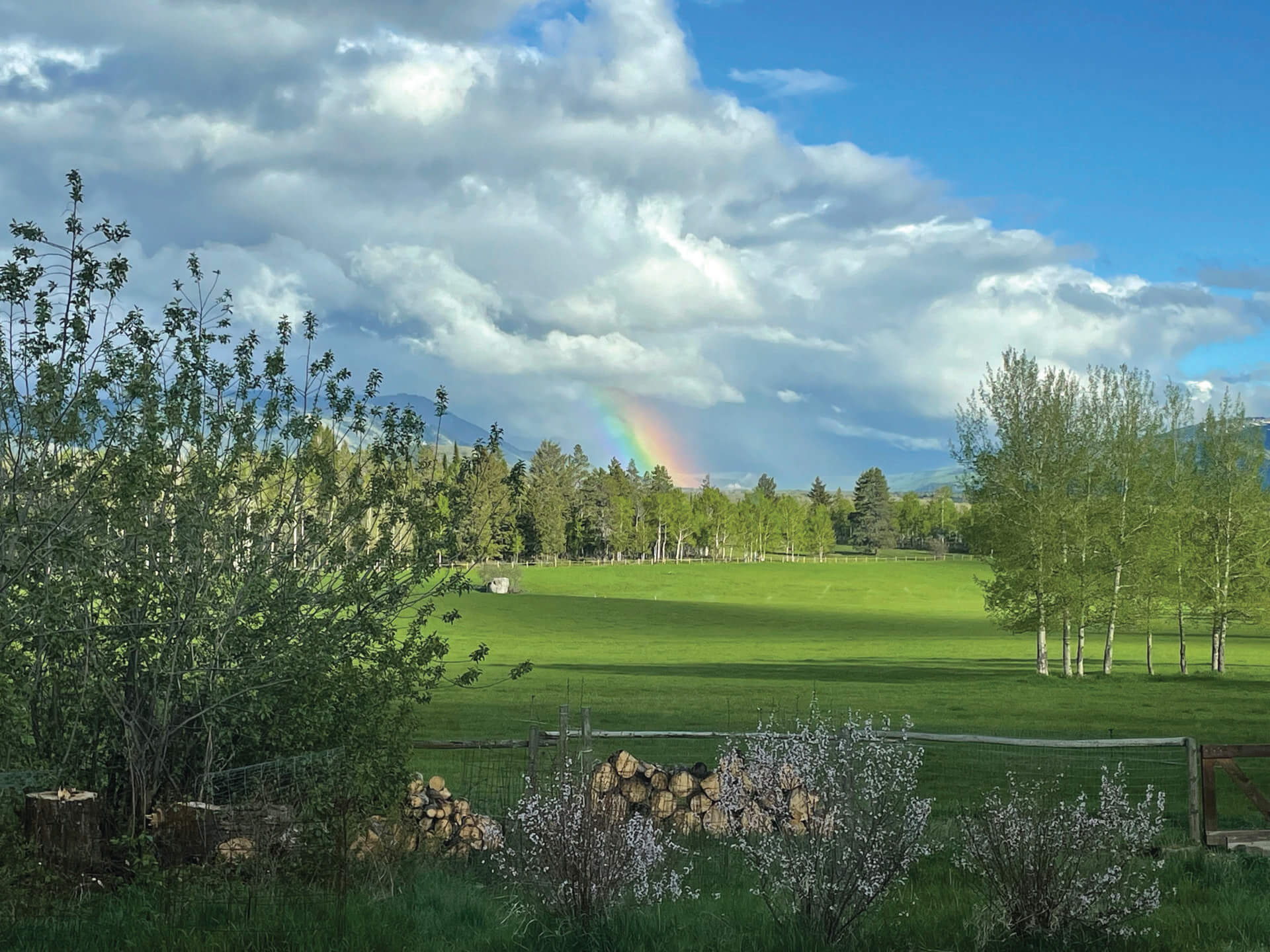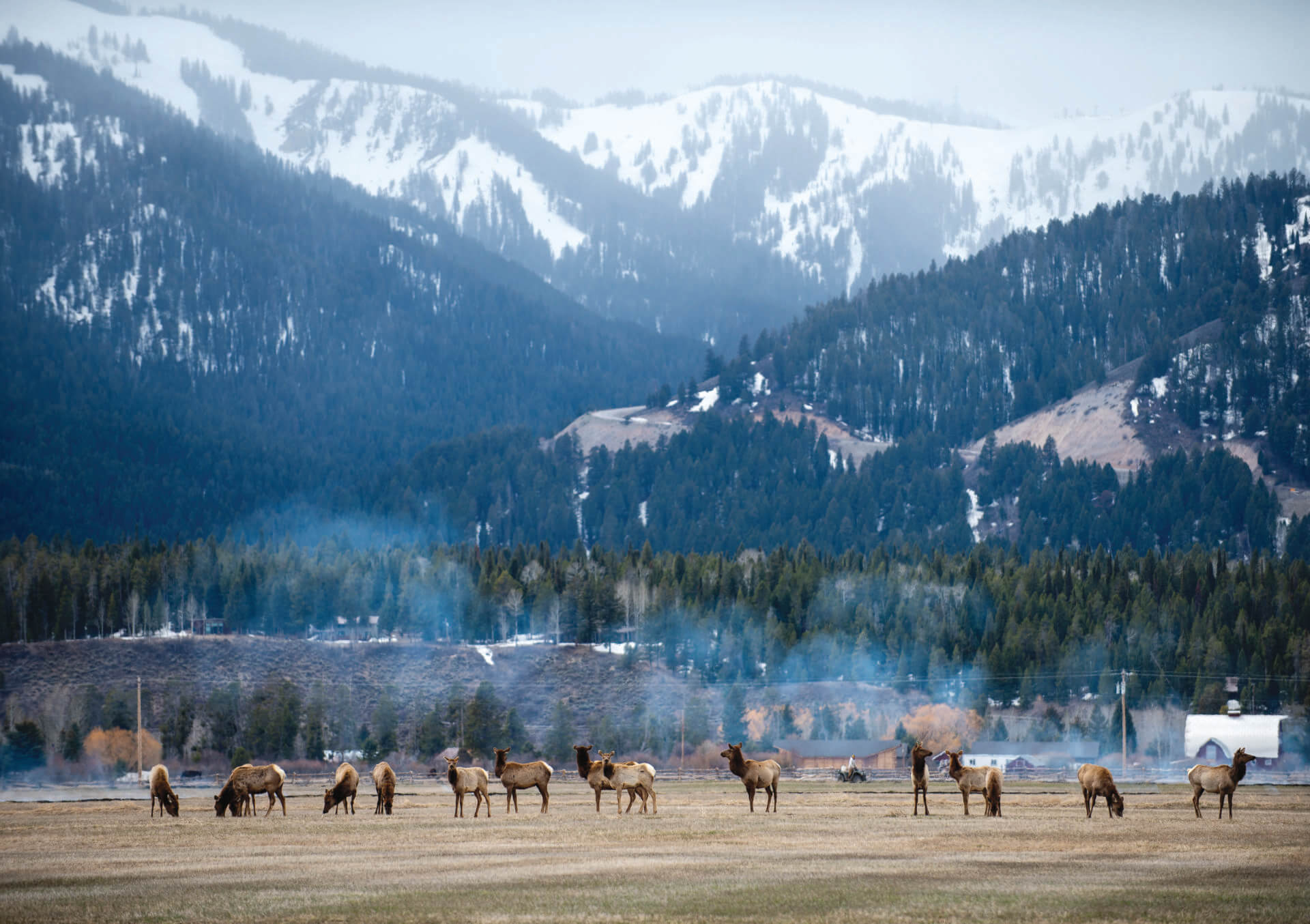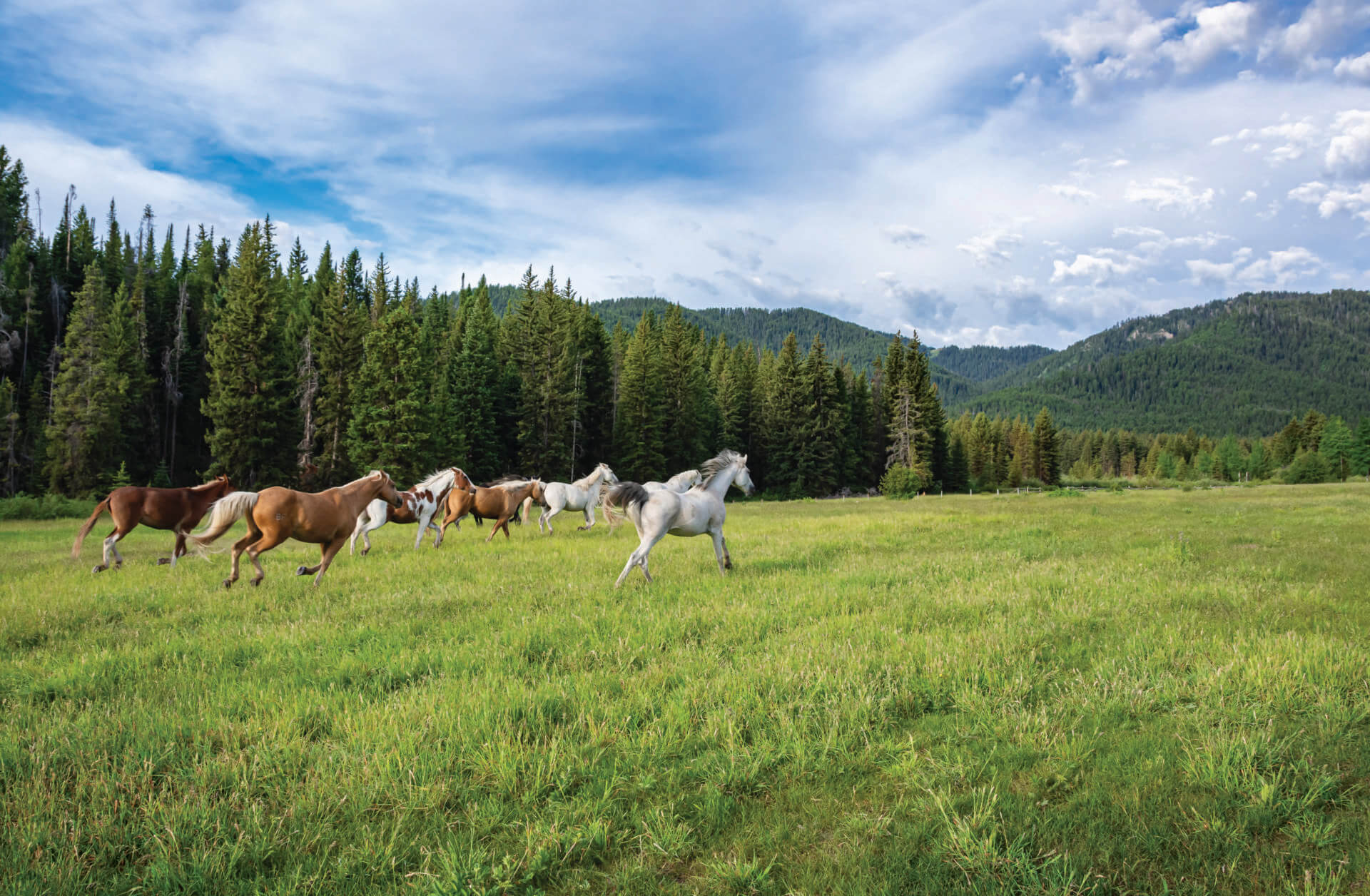Read The
Current Issue
Preservation or Pricing Out?
Do conservation easements protect open space and wildlife at the expense of the Jackson Hole community?
//By Brigid Mander

When Claire Fuller steps outside her home on the Huidekoper Ranch in Wilson, it’s as if she’s seeing a scene from Teton County’s past: This small, high-alpine farming operation, which supplies local markets and restaurants with quality produce, also has a smattering of open fields supporting a horse-boarding and haying operation. And a couple of greenhouses, sheds, and two modest homes flanked by aspen and pine forests round out the 140-acre property, home to Fuller, her husband, Brent Tyc, and her brother Nate Fuller
Elk, mule deer, migratory birds, raptors, and other wildlife frequent the property as their ancestors have done for millennia. And despite the ultra-lucrative market for pristine land to subdivide for the construction of luxury homes, that’s not the future for this bucolic acreage and wildlife habitat. Ever.
When Claire’s grandmother, Virginia Huidekoper, passed down the ranch to her heirs in 1997, she did not grant a commodity to be divided and sold. Instead, she passed a place to live along with a responsibility, a moral ethic, and the idea of something greater than transient fiscal profit: stewardship of land, wildlife, and nature.
When Claire’s grandmother, Virginia Huidekoper, passed down the ranch to her heirs in 1997, she passed a place to live along with a responsibility, a moral ethic, and the idea of something greater than transient fiscal profit: stewardship of land, wildlife, and nature.
Huidekoper herself was a larger-than-life local character. Among her contributions to the valley, she was an author, climber, skier, and co-founder of the Jackson Hole News; and she piloted the flight that verified and documented Bill Briggs’s first ski descent of the Grand Teton in 1971. She donated her land’s development rights to the Jackson Hole Land Trust (JHLT). Land trusts are entities that purchase or accept donations of development rights, hold them in perpetuity, and monitor each parcel annually to ensure compliance with the original agreement regardless of the current owner.
Even if the Fullers—or any future landowner—would like to build another house for a family member or use the land in another way, the easement agreement Huidekoper created prohibits it. “‘No development’ cuts both ways,” Fuller says. “But this place and the wildlife were here before me, and they will be here after me. It’s a really big choice for nonwealthy landowners, but fundamentally it comes down to different worldviews: stewardship of the land, or land as an investment vehicle.”

The region surrounding and including Teton County is cherished and known worldwide for vast preserved landscapes, wildlife, and wildernesses existing alongside contained corridors of human development. This did not occur by accident. It was a choice made by the government and people at the onset of European colonization here around the 1870s to limit industrial and other development and preserve a vast, geologically unique, and pristine wild place. (The U.S. Congress created Yellowstone National Park in 1872.) An oft-recited statistic is that 97 percent of the county’s more than 2.5 million acres is federally owned and managed public land, including Grand Teton National Park, part of Yellowstone, the National Elk Refuge, and part of the Bridger-Teton National Forest. That leaves only 3 percent of the land within county boundaries available to be privately owned.
This causes problems. According to the 2023 year-end Jackson Hole Real Estate Report, the average price of the 64 single-family homes sold that year in Jackson Hole was $5.04 million; in all of 2023, only three properties sold for less than $1 million. For others, however, the problem is that 97 percent is not enough conservation in a location critical to wildlife. Some who fall into this camp see conservation easements as a way to protect private land from development.
This group—proponents of public land and conservation over more development—say Teton County demands an exemplary level of land stewardship. The county is part of the Greater Yellowstone Ecosystem (GYE), which, depending on how it is defined, encompasses between 15 and 22 million acres in Wyoming, Idaho, and Montana. Yellowstone National Park is the ecosystem’s heart, but the area’s wildlife migrate around and through hundreds of miles surrounding the park. The GYE is among the world’s last few intact ecosystems; all the wild animals, apex predators, and long-distance migrations that existed in the region before the 1804–1806 Lewis and Clark Expedition still survive here. “There are only two intact temperate ecosystems left across the world: Tanzania’s Serengeti in Africa and right here,” says Max Ludington, president of the nonprofit Jackson Hole Land Trust. “At one point, these ecosystems existed everywhere across the world, and it remains here only because it’s been protected.”
Yet development pressure is relentless, and residents and visitors sometimes question why there is so much public land and why any of the remaining 3 percent of private land should be protected from development. Part of the answer, says Ludington, is the location of the private land. “Homesteading was done where there is water. Water is the most critical resource for wildlife.” Today, development is heavily concentrated on the valley floor, but many of the remaining large rural tracts of land are along rivers and creeks, and provide interconnected corridors of public and private lands animals need to move, thrive, and migrate.
“National parks and forests are an important anchor, but private lands surrounding these public lands are essential to support big game migration and survival. Animals cannot have sustainable populations without an open and connected landscape,” says Jill Randall, big game migration coordinator for Wyoming Game & Fish. “Once land has been subdivided, it never goes back to functioning at a high level for wildlife.” Since it was founded in 1980, the JHLT has helped permanently protect more than 20,000 acres of land, including large tracts like the 1,848-acre Walton Ranch off Wyoming Highway 22 and a host of smaller properties.

A conservation easement is a legal tool through which a landowner removes or restricts the development rights while maintaining ownership of the land. The process can seem opaque, and misunderstandings and misrepresentations are common. Not every piece of land qualifies for an easement. “Under the federal tax code, to be a deductible contribution, an easement must meet one or more of four requirements set by the Internal Revenue Service,” says Luther Propst, a Teton County Commissioner and conservation advocate. The four requirements are: protect habitat, preserve open space, preserve outdoor recreation, or preserve historically important land or buildings.
Trail Creek Ranch provides open space, wildlife habitat, and migration passage, and, in the winter, is open to public use as a Nordic ski trail system.
A landowner can donate the value of the development rights as a charitable contribution, which can provide a partial income tax break over a period of years. On the other hand, if a nonwealthy landowner wishes to protect a large property valuable for wildlife or agriculture but can’t afford to donate development rights, a land trust and a variety of nonprofits—usually environmental and wildlife-conservation organizations—will purchase them. The money comes from federal and state funds and private donations.
This sale or donation of development rights is in perpetuity, a fundamental requirement of an easement. The original agreement is nonnegotiable and permanently tied to the land, not ownership. Compliance is enforced via annual inspections per each agreement; a new landowner may not, for example, clear forests or add fences or buildings if the original contract prohibits it.
Ultimately, a conservation easement is the opposite action of an owner choosing to build as much as is allowed by zoning or waiver. The landowner is able to decide the development future. Both types of actions have impacts on the human community, wildlife, and the surrounding environment.
Amid affordable-housing woes, conservation easements can attract ire because they remove land from the development pool. However, if developed, most of these large, rural tracts of land would likely become luxury homes for retirees, vacation home owners, or remote workers, says Propst. “This kind of development would make the local housing crunch worse by creating more low-wage service jobs and seasonal jobs. Preservation via easement prevents that and serves an open space and wildlife purpose.”
At the Mead Ranch, a cattle operation in Spring Gulch near Jackson, multiple conservation easements provide support for wildlife and local food production. “My grandmother announced she never wanted to see a big house in Spring Gulch by Highway 22,” says Brad Mead, who lives on the ranch. Mead is not oblivious to land-use discussions in Teton County, but he stands by his family’s choice. “There is an interesting tension between housing and conservation. But realistically, easement properties are not going to become high-density or affordable housing. Our easements still permit us to graze cows and ranch, so it isn’t totally pristine. But the protected property is wildlife friendly, and it will remain undeveloped.”

Teton County is not the only place where conservation easements preserve wildlife habitat and prevent overdevelopment and sprawling subdivisions fragmenting the landscape. Statewide, Wyoming has seen rising development pressure and affordability issues, according to Jessica Crowder, executive director of the Cheyenne-based Wyoming Stock Grower’s Land Trust. “Agricultural land protection is our priority, and so what we see from landowners [seeking an easement] is a desire to keep the lands available for agriculture, for wildlife, and to pass it to the next generation.”
That was the case in 2010, when Sublette County rancher Albert Sommers and his family, along with the neighboring Grindstone Cattle Company, placed 19,000 acres of ranchland and critical wildlife habitat along the Green River in a conservation easement. In addition to protecting wildlife habitat, the goal was to preserve small-scale ranching and agricultural traditions and keep local food production possible. The agreement also opened up five miles of riverbank fishing to the public.
“We wanted to preserve the agricultural tradition and landscape; that’s what preserves wildlife. And
any time you protect or enhance the state’s wildlife, that’s also a public good.”—Albert Sommers, Rancher and state representative for Sublette County
Named the Sommers-Grindstone Conservation Project, it is a partnership between the landowners, the Wyoming Game and Fish Commission, and the Wyoming Stock Growers Land Trust. A portion of development value was donated, but the majority was purchased by wildlife-conservation nonprofits. The easement is held by the Wyoming Stock Growers Land Trust.
“We still own our land, just not the development right. It’s the landowner’s right to sell, like we could sell mineral rights, or water, or hunting rights. But we wanted to preserve the agricultural tradition and landscape; that’s what preserves wildlife. And any time you protect or enhance the state’s wildlife, that’s also a public good,” says Sommers, who is a now state representative for Sublette County and the current head of the Wyoming State Legislature. “Eventually we will gift the ranch to the next generation, a neighbor’s boy who is already working the ranch. Conservation easements help preserve everything we love about Wyoming.”
Those who work at land trusts understand the complexities, from the decision to the agreement to public opinion. “A conservation easement is a big decision for a family to make and protect their land in this way,” says the Stockgrowers Land Trust’s Crowder. “It also means we have to be more intentional about what, where, and how development does take place.”
Generally, land under an easement is not open to the public, since it remains private property. But one prominent conservation easement is Trail Creek Ranch in Wilson. Upon her death in 1997, Elizabeth “Betty” Woolsey, a climber and backcountry and Olympic skier who bought the ranch in 1943, placed a conservation easement with the JHLT on the 270-acre ranch. Today, Trail Creek, which Woolsey used as a basecamp from which she guided some of the earliest backcountry skiers on Teton Pass, provides open space, wildlife habitat, and migration passage, and, in the winter, is open to public use as a Nordic ski trail system. An adjacent property, the Gill-Huff Ranch, is also under easement and allows wildlife habitat and ski trail continuity across the property.
The goal of the Land Trust’s 2019 “Save the Block” campaign was to raise enough money to purchase and place under a historic preservation easement two acres close to the Jackson Town Square. Although this area included the sole patch of green space in the heart of downtown that isn’t the Town Square and historic cabins home to beloved local businesses, it was going to be developed into a large, luxury hotel. Led by the Jackson Hole Land Trust, in about five months the campaign received donations from $1 to $1 million from more than 5,700 individuals. While the two log cabins on it might not always be home to Persephone Bakery Café and Healthy Being Juicery, the Block is now forever home to public green space and is permanently protected from additional development.
Rendezvous Park—R Park—is another public area made possible by easements. Owned and operated by the JHLT, the 40-acre R Park is the only nonprofit park in Jackson Hole. On the West Bank of the Snake River near the intersection of Wyoming Highways 390 and 22, today the park is home to ponds, sledding hills, meadows and wetlands (aka wildlife habitat), and a large sculpture of a troll created from reclaimed materials. Formerly, part of it was a gravel pit. Had the JHLT not stepped in, this land would likely have become a small community of large homes.

America is a nation with a penchant for sprawling development, which has fragmented the land, and, in many cases, destroyed the ability of wildlife to live on the land. In the northwestern corner of the GYE near Bozeman, Montana, development demand plus a lack of protected land has resulted in open spaces quickly falling to subdivisions, buildings, and more roads. Yet housing prices there have nonetheless risen, and biologists see wildlife-migration corridors and food sources, and thus herds and individual animals, being destroyed in real time.
The aggressive building of new homes along the Front Range of Colorado, too, has not guaranteed affordability. In 2022, the Front Range cities of Denver, Colorado Springs, and Pueblo were ranked in the top 10 of unaffordable cities based on rankings by Ojo Labs, a Texas-based real estate tech firm. And the sprawling development there has fomented intense traffic congestion, a loss of grasslands, open agricultural land, and fragmented, severely dwindling wildlife populations.
“A lot of people point to zoning and housing regulations, conservation or federal lands, but even if we repealed all these regulations, we’d still have an affordable-housing problem because of the external demand.”
—Bill Collins, Teton County planning and development director
Is it a myth that conservation easements affect the fundamental equation of supply and demand in housing development and pricing? According to Bill Collins, a Teton County planning and development director from 1993 to 2004, conserved lands have little to do with affordability issues. Instead, he says it is the limitless demand for second homes and investment properties and remote workers with purchasing power that far surpasses that of most local workers. “A lot of people point to zoning and housing regulations, conservation, or federal lands, but even if we repealed all these regulations, we’d still have an affordable-housing problem because of the external demand,” Collins says.
It can be difficult to look past immediate human problems and appreciate the long-term vision of most conservation easements. But people can move and live other places, and the GYE’s wildlife cannot. “The GYE is one of the only places on Earth that still supports long-distance migrations for multiple species across the same landscape,” says WYGF’s Randall. “Conservation easements are one of the best tools to ensure we maintain this ecological phenomenon into the future.”
Fuller says, “I think there is value in undeveloped places, and it highlights a fundamental ethic. Do we want to be here because of the open spaces and wildlife, or despite it?” JH





